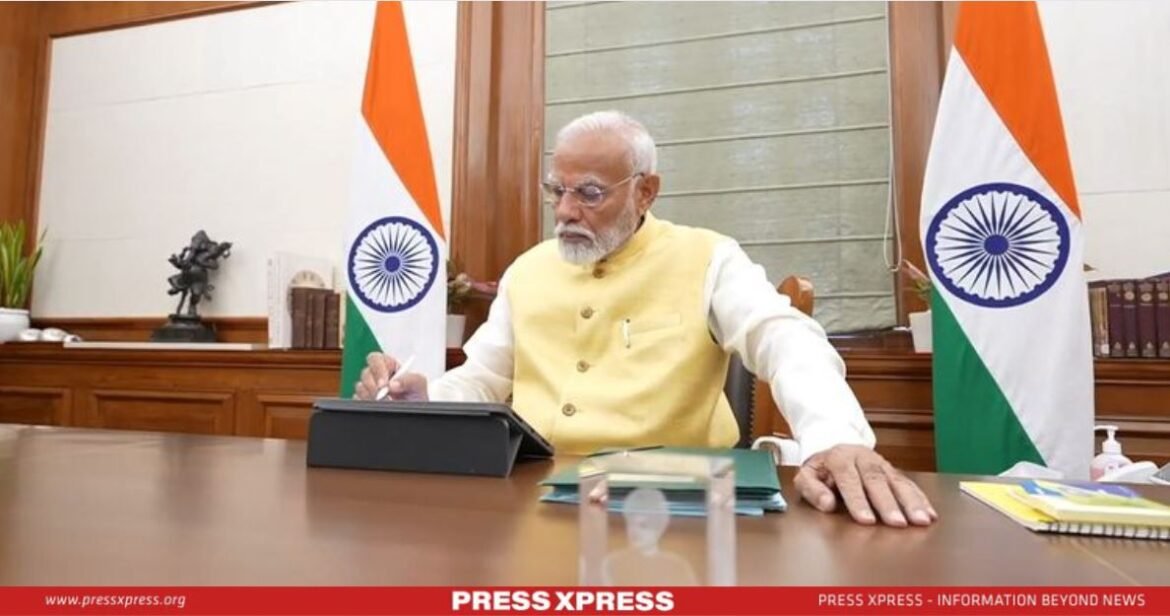Narendra Modi was sworn in as the Prime Minister of India for his third consecutive term on June 10, 2024, at the ‘Rashtrapati Bhavan’ of India. President Droupadi Murmu administered the oath to Modi, followed by the swearing-in of his cabinet members.
You can also read: Sheikh Hasina, Sonia Gandhi photos go viral in India
This marks a pivotal moment in Indian politics, with Modi leading the BJP-led NDA to a third successive victory in the Lok Sabha polls since 2014 elections.
Highlights from Modi’s First Day in Office
In his first address to the officials of the Prime Minister’s Office (PMO) upon returning to office for the third time, PM Modi stressed continuous upgradation and innovation, stating, “What new can be done in the team which gave me so much in 10 years, how we can do ever better, how we can do ever quicker, how we can do it on a better scale – if we go ahead together with all of these, I am confident that the 140-crore people of the country have put their stamp of approval on their efforts.” He also expressed the importance of the election wins, stating that those wins are not just a result of his speeches but of each and every government employee who has served in the past ten years.
Modi’s first move in office was to authorize the release of the 17th installment of the ‘PM Kisan Nidhi’ funds, amounting to nearly Rs20,000 crore. The move is expected to benefit 90 million farmers. Arriving at his office in South Block on the first morning after taking the oath, PM Modi signed the file related to the installment for farmers under the flagship scheme, underlining the government’s focus on farmers’ welfare.
“Ours is a government fully committed to ‘kisan kalyan’ (farmers’ welfare). It is, therefore, fitting that the first file signed on taking charge is related to it. We want to keep working even more for farmers and the agriculture sector in the coming times,” Modi said.
A strategic ministerial formation
Modi’s 3.0 Cabinet includes 33 first-time union ministers, seven from alliance partners, reflecting a mix of youth and experience. Notably, K Rammohan Naidu (37) is the youngest-ever Cabinet minister in the NDA government. The selection aims to strike a regional balance across various states, including those where elections are due soon.
The new Council of Ministers will comprise 11 ministers belonging to NDA allies. The Modi Cabinet 3.0 comprises of 30 Cabinet Ministers, 5 Ministers of State with Independent Charge and 36 Ministers of State. Three former CMs and actor-turned-politician Suresh Gopi, the first Lok Sabha MP of BJP from Kerala, were among those who took their oath.
Modi will lead a 72-member Union Council of Ministers with increased representation from NDA partners, overseeing 47 ministries for the next five years. Over the next three months, the union ministers are to carry out the blueprint for the first 100-day roadmap of the Modi government.
“This team of ministers is a great blend of youth and experience; we will leave no stone unturned in improving people’s lives. I look forward to serving 140 crore Indians and working with the Council of Ministers to take India to new heights of progress,” PM Modi said in a post on X after the ceremony.
Key areas of focus in Modi 3.0
As Prime Minister Modi begins his third term, some vital areas including defense and public policy initiatives will get priority. The government intends to establish a new export promotion body, as mentioned by The Economic Times. Other key initiatives include the Rafale M fighter jets acquisition and DRDO reforms. Discussion on the controversial Agnipath military recruitment scheme, strongly opposed by BJP’s coalition partners, Janata Dal-United, and Jana Shakti Party (Ram Vilas), may also arise, as per experts.
Thousands of new criminal laws are set to be implemented by the Home Ministry starting July 1. The government is also working towards holding assembly elections in Jammu and Kashmir.
On the international front, India’s foreign policy in PM Modi’s historic third straight term begins with a meeting of BRICS (Brazil-Russia-India-China-South Africa) Foreign Ministers in Nizhny Novgorod, Russia. The two-day meeting, chaired by Russian Foreign Minister Sergey Lavrov, paves the way for the BRICS Summit in October. The BRICS Foreign Ministers’ meeting took place in Cape Town, South Africa, last year and was attended by External Affairs Minister S. Jaishankar, who is likely to attend again this year. This framework will also provide for a separate meeting of a grouping of countries from the Global South and East.
Lastly, PM Modi has set ambitious goals for India’s future, promising to elevate the nation to new heights globally and continue the remarkable transformation observed under his leadership. As he embarks on this historic third term, the country and world will eye on the advancements and progress that India is promised to get from his leadership in the upcoming five years.


